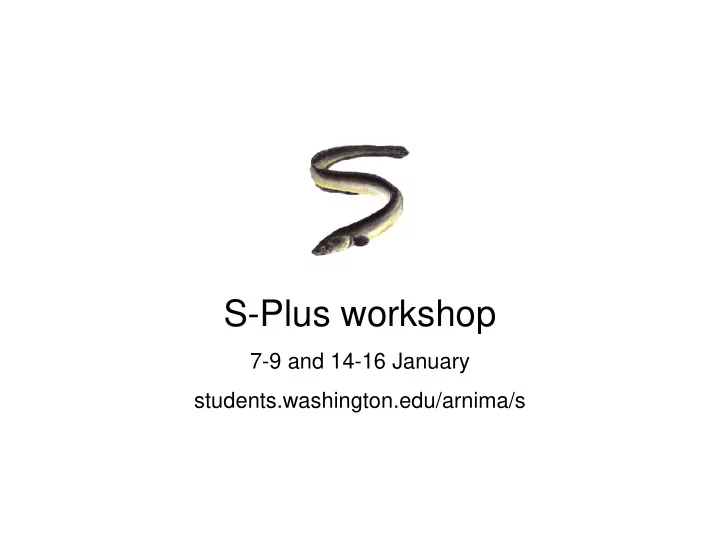

S-Plus workshop 7-9 and 14-16 January students.washington.edu/arnima/s
Syllabus Tue 7 Introduction Import data, summarize, regression, plots, export graphs Wed 8 Basic statistics Descriptive statistics, significance tests, linear models Thu 9 Linear models Anova, LM, GLM, loess Tue 14 Graphics Types, multipanel, export graphs Wed 15 Data manipulation Data objects, describe, extract, sort, manipulate Thu 16 Programming Functions, import/export, project management, packages Arni Magnusson 9 January 2003
Today: Linear models 1 Object anatomy lm, summary 2 Regression plots plot, loess, boxplot, coplot, interaction.plot, diagnostic plots 3 Auxiliary functions extract elements, build models, predict, diagnose, transform 4 Exercise weight loss Arni Magnusson 9 January 2003
Fetch data and create models library(MASS) #R: data(mammals, cabbages) #S: mammals <- mammals #S: cabbages <- cabbages mammals.lm <- lm(log(brain)~log(body), data=mammals) cabbages.aov <- aov(VitC~Cult+Date, data=cabbages) cabbages.lm <- lm(VitC~HeadWt, data=cabbages) cabbages.ancova <- lm(VitC~HeadWt+Cult*Date, data=cabbages) Arni Magnusson 9 January 2003
Object anatomy - How they print mammals.lm Call: lm(formula = log(brain) ~ log(body), data = mammals) Coefficients: (Intercept) log(body) 2.1348 0.7517 #S: Degrees of freedom: 62 total; 60 residual #S: Residual standard error: 0.6942947 Arni Magnusson 9 January 2003
Object anatomy - How they print summary(mammals.lm) #R: summary(mammals.lm, cor=T) Call: lm(formula = log(brain) ~ log(body), data = mammals) Residuals: Min 1Q Median 3Q Max -1.71550 -0.49228 -0.06162 0.43597 1.94829 Coefficients: Estimate Std. Error t value Pr(>|t|) (Intercept) 2.13479 0.09604 22.23 <2e-16 *** log(body) 0.75169 0.02846 26.41 <2e-16 *** --- Signif. codes: 0 `***' 0.001 `**' 0.01 `*' 0.05 `.' 0.1 ` ' 1 Residual standard error: 0.6943 on 60 degrees of freedom Multiple R-Squared: 0.9208, Adjusted R-squared: 0.9195 F-statistic: 697.4 on 1 and 60 DF, p-value: < 2.2e-16 Correlation of Coefficients: (Intercept) log(body) -0.3964 Arni Magnusson 9 January 2003
Object anatomy - What’s inside names(mammals.lm) call # recipe, what we can type to create this model coefficients # parameter estimates fitted.values residuals rank # number of parameters estimates, df used df.residual # residual degrees of freedom, df left mammals.lm$call mammals.lm$coe mammals.lm$fit mammals.lm$res mammals.lm$rank mammals.lm$df.res Arni Magnusson 9 January 2003
Object anatomy - What’s inside names(summary(mammals.lm)) coefficients # parameter estimates and t test of β =0 r.squared correlation # between parameter estimates summary(mammals.lm)$coe x <- summary(mammals.lm) x$coe x$r.s x$cor Arni Magnusson 9 January 2003
Symbols - Formula notation ~ # is a function of y ~ x + # add term y ~ x1 + x2 : # interaction term y ~ x1 + x2 + x1:x2 I # do not interpret y ~ x1 + I(x2+x3) * # both terms and their interaction y ~ x1 * x2 - # but not this term y ~ x1 * x2 - x2 . # same as before y ~ . + x3 Arni Magnusson 9 January 2003
Symbols - Formula notation lm(y~1) # estimate intercept only, null model lm(y~-1+x) # estimate slope, fix intercept at 0 lm(offset(y-3)~-1+x) # estimate slope, fix intercept at 3 lm(y~offset(3*x)) # estimate intercept, fix slope at 3 ?formula Arni Magnusson 9 January 2003
Symbols - ( ) [ ] { } f(x) # Pass argument x to function f x[i] # Extract element i from vector x {cmd} # Lump commands together as a block, used when programming Arni Magnusson 9 January 2003
Regression plots Arni Magnusson 9 January 2003
Scatterplot and friends plot(log(mammals$body), log(mammals$brain)) abline(mammals.lm) points(5, 0) points(5, 0, cex=2) lines(c(6,4,5), c(0,1,-1)) x.human <- log(mammals$body)[row.names(mammals)=="Human"] x.human y.human <- log(mammals$brain)[row.names(mammals)=="Human"] points(x.human, y.human, pch=3, cex=2) text(x.human, y.human+0.5, "me") Arni Magnusson 9 January 2003
Smoothing with loess #R: library(modreg) plot(log(mammals$body), log(mammals$brain)) mammals.loess <- loess(log(brain)~log(body), data=mammals) mammals.loess summary(mammals.loess) names(mammals.loess) call # recipe, what we can type to create this model fitted mammals.loess$fit cbind(log(mammals), mammals.loess$fit) Arni Magnusson 9 January 2003
Smoothing with loess points(log(mammals$body), mammals.loess$fit, col=6) lines(log(mammals$body), mammals.loess$fit, col=6) x <- log(mammals$body) y <- mammals.loess$fit plot(log(mammals$body), log(mammals$brain)) lines(x[order(x)], y[order(x)]) Arni Magnusson 9 January 2003
Box plot boxplot(cabbages$VitC) boxplot(split(cabbages$VitC, cabbages$Date)) Arni Magnusson 9 January 2003
Conditioning plot #R: library(lattice) coplot(VitC~HeadWt|Cult, data=cabbages) coplot(VitC~HeadWt|Cult, data=cabbages, panel=panel.smooth) coplot(VitC~HeadWt|Date, data=cabbages, panel=panel.smooth, rows=1) coplot(VitC~HeadWt|Date*Cult, data=cabbages, panel=panel.smooth) #S: coplot(VitC~HeadWt|Date*Cult, data=cabbages, panel=panel.smooth, span=0.9) Arni Magnusson 9 January 2003
Interaction plot interaction.plot(cabbages$Cult, cabbages$Date, cabbages$VitC) Arni Magnusson 9 January 2003
Plot influence diagnostics par(mfrow=c(2,3)) #R: par(mfrow=c(2,2)) plot(mammals.lm) par(mfrow=c(1,1)) plot(mammals.lm$fit, mammals.lm$res) abline(h=0) identify(mammals.lm$fit, mammals.lm$res, row.names(mammals)) Arni Magnusson 9 January 2003
Auxiliary functions Arni Magnusson 9 January 2003
Formal extraction of elements coef(mammals.lm) # same as mammals.lm$coef fitted(mammals.lm) # same as mammals.lm$fitted residuals(mammals.lm) # select one of five different kinds of residuals args(residuals.lm) deviance(mammals.lm) # GLM context, for lm this is SSE=sum(mammals.lm$res^2) Arni Magnusson 9 January 2003
Model building and selection update(mammals.lm, .~.+I(body^2)) cabbages.0 <- lm(VitC~1, data=cabbages) # null model, intercept only cabbages.full <- update(cabbages.0, .~.+HeadWt*Cult*Date) add1(cabbages.0, cabbages.full) drop1(cabbages.full) cabbages.step <- step(cabbages.0, list(lower=cabbages.0, upper=cabbages.full)) cabbages.step anova(cabbages.full) cabbages.plain <- update(cabbages.0, .~.+HeadWt+Cult+Date) AIC(cabbages.0, cabbages.plain, cabbages.full) Arni Magnusson 9 January 2003
Predict from new data new.cabbage <- data.frame(Cult="c39", Date="d16", HeadWt=4.0) predict(cabbages.plain, new.cabbage) predict(cabbages.full, new.cabbage) exp(predict(mammals.lm, data.frame(body=100))) Arni Magnusson 9 January 2003
Influence diagnostics mammals.diag <- ls.diag(mammals.lm) #S: mammals.diag <- ls.diag(lsfit(log(mammals$body), log(mammals$brain))) plot(mammals.diag$cooks, type="h") abline(h=0) See slide: Plot influence diagnostics Arni Magnusson 9 January 2003
Transform response variable mammals.plain <- update(mammals.lm, brain~body) library(MASS) plot(boxcox(mammals.plain)) # evaluate 1/Y, log(Y), Y, Y^2, ... plot(logtrans(mammals.plain)) # evaluate log(Y+0.1), log(Y+1), ... Arni Magnusson 9 January 2003
Models related to lm and aov ?glm ?gam #R: library(mgcv) ?nls #R: library(nls) Arni Magnusson 9 January 2003
Caveats I recommend never using attach() on data frames. Extract residuals from lm and aov objects using the lazy $res, but use formal residuals(x,type="") for other models. Arni Magnusson 9 January 2003
Exercise: weight loss library(MASS) #R: data(wtloss) wtloss <- wtloss Analyze the data: - Fit a model that goes through the data reasonably well - Paste a table and graph into Word - Bonus question: one might be interested in predicting the person’s weight after two years at the health clinic Arni Magnusson 9 January 2003
Recommend
More recommend